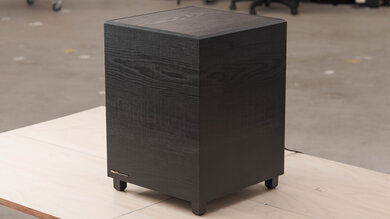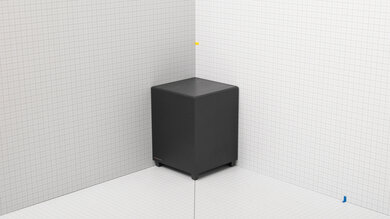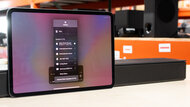The Klipsch Cinema 400 is a 2.1 setup from the company's 2020 lineup. It comes with a dedicated subwoofer, which helps reproduce a present and punchy bass. Out-of-the-box, it has a very neutral sound profile suitable for listening to lots of different types of audio content. Unfortunately, there aren't a lot of sound customization features available. It also has to downmix surround content into stereo, and it doesn't support Atmos content.
Our Verdict
The Klipsch Cinema 400 soundbar is fair for mixed usage. Its balanced sound profile makes it suitable for listening to lots of different audio content. Even though it lacks a dedicated center channel, dialogue in TV shows is clear and accurate. You can also use its subwoofer level adjustment to customize its sound. However, it has to downmix surround content into stereo, which doesn't sound as immersive. It also doesn't support Dolby Atmos content.
-
Subwoofer level adjustment.
-
Subwoofer level adjustment available.
-
Bluetooth-compatible.
-
Doesn't support Dolby Atmos.
-
Downmixes surround content into stereo.
-
Compression at max volume.
The Klipsch Cinema 400 soundbar is very good for dialogue-centric content like TV shows. Its balanced mid-range can reproduce clear and accurate vocals, and it even has an adjustable dialogue enhancement feature to help make voices sound even crisper. You can also stream podcasts and audiobooks from your phone to the bar wirelessly via Bluetooth. Unfortunately, while it gets pretty loud, there's some compression at max volume. It also lacks a dedicated center channel.
-
Subwoofer level adjustment.
-
Adjustable dialogue enhancement mode.
-
Bluetooth-compatible.
-
Phantom center channel.
-
Compression at max volume.
The Klipsch Cinema 400 is decent for music. It has a very neutral sound profile out-of-the-box, making it suitable for listening to lots of different music genres. You can also use the subwoofer level adjustment feature to customize its sound more to your liking. Unfortunately, while it can get pretty loud, there's compression at max volume. It also lacks a full graphic EQ for greater sound customization.
-
Subwoofer level adjustment.
-
Subwoofer level adjustment available.
-
Compression at max volume.
-
Okay soundstage performance.
The Klipsch Cinema 400 is acceptable for movies. It has a very neutral, balanced sound profile that can reproduce clear dialogue, as well as the deep thumps and rumbles in action-packed scenes. It can get pretty loud, but unfortunately, there's some compression when you play it at max volume. It also has to downmix surround content into stereo, which isn't as immersive, and it doesn't support Dolby Atmos content.
-
Subwoofer level adjustment.
-
Subwoofer level adjustment available.
-
Doesn't support Dolby Atmos.
-
Downmixes surround content into stereo.
-
Compression at max volume.
- 6.9 Mixed Usage
- 7.8 Dialogue/TV Shows
- 7.1 Music
- 6.1 Movies
Changelog
- Updated Apr 06, 2023: Added cable lengths to In The Box.
- Updated Apr 05, 2023: Converted to Test Bench 1.1. With this update, we've added a Mounting test and added information aboutSubwoofer Output, Spotify Connect, and Microphone Mute.
- Updated Mar 30, 2021: Changed our EQ result to make the results more clear.
- Updated Feb 18, 2021: Review published.
- Updated Feb 15, 2021: Early access published.
Check Price
Differences Between Sizes And Variants
The Klipsch Cinema 400 comes in 'Black', and you can see the label for the model we tested here.
If you come across another version, let us know in the discussions so we can update our review.
Compared To Other Soundbars
The Klipsch Cinema 400 is a 2.1 setup with a very neutral, balanced sound profile out-of-the-box that makes it suitable for listening to lots of different types of audio content. Unlike the Klipsch Cinema 600, it doesn't have a dedicated center channel, so dialogue-centric content doesn't sound as real or clear. That said, it comes with an auto-volume mode and an adjustable dialogue enhancement feature. See also our recommendations for the best soundbars under $300, the best soundbars for dialogue, and the best soundbars.
The Sonos Beam is better than the Klipsch Cinema 400. The Sonos is a 3.0 setup that's better built and gets louder. It has better soundstage, center, and surround performances. Unlike the Klipsch, it has room correction and built-in voice assistant support. However, the 2.1 Klipsch comes with a dedicated sub that helps reproduce a more extended low-bass.
The Klipsch Cinema 600 is a better soundbar than the Klipsch Cinema 400. The 600 is a 3.1 setup, so it has a dedicated center channel that can reproduce dialogue-centric content more accurately. It also has a better soundstage performance, and it gets louder. That said, the 400 has a more balanced sound profile out-of-the-box.
The Sonos Beam (Gen 2) is better than the Klipsch Cinema 400. The Sonos is a better-built 5.0 setup that supports Dolby Atmos content. It has better soundstage, center, and surround performances. Unlike the Klipsch, it has built-in voice assistant support and a room correction feature. However, the 2.1 Klipsch comes with a dedicated sub, and it's able to reproduce a more extended low-bass.
The Sony HT-G700 is better for mixed usage than the Klipsch Cinema 400. The Sony is a better built 3.1 setup that supports Dolby Atmos content, unlike the Klipsch. It also has better center and surround performances. That said, the 2.1 Klipsch is still a solid choice for music and dialogue-centric content like TV shows. It can actually reproduce a more extended low-bass than the Sony.
The Klipsch Cinema 400 is a better soundbar than the Klipsch Bar 48. The Cinema 400 has a more neutral, balanced sound profile, so it's suitable for lots of different types of audio content. However, the Bar 48 is better built, and it has a better center channel performance thanks to its 3.1 setup.
The JBL Bar 5.1 Surround is a bit better for mixed usage than the Klipsch Cinema 400. The JBL is a 5.1 setup that's better built and offers better center and surround performances. Unlike the Klipsch, it even has a Full HDMI In port for high quality passthrough. That said, the 2.1 Klipsch can reproduce a more extended low-bass.
The Sonos Arc is better than the Klipsch Cinema 400. The Sonos is a 5.0.2 setup, is better built, and supports Dolby Atmos content. It has better soundstage, center, and surround performances, and it has room correction. Unlike the Klipsch, it has built-in voice assistant support. The 2.1 Klipsch has a dedicated sub that helps reproduce a more extended low-bass.
Depending on your listening habits, you may prefer either the Bose Smart Soundbar 300 or the Klipsch Cinema 400. The Bose is a better built 3.0 setup with better soundstage and center channel performances. It also gets louder, and it has built-in voice assistant capabilities. However, the Klipsch comes with a dedicated sub that can reproduce a more extended low-bass.
The Samsung HW-T550 is a better soundbar than the Klipsch Cinema 400. The Samsung is better-built, it gets louder, and it has more sound enhancement features, including a graphic EQ. It also has a better soundstage performance. However, the Klipsch has a more neutral sound profile out-of-the-box.
The Yamaha YAS-209 and the Klipsch Cinema 400 are both very similarly performing 2.1 setups, but depending on your listening habits, you may prefer one over the other. The Klipsch has a better-balanced sound profile out-of-the-box, and it also comes with more sound enhancement features, including an auto-volume mode. However, the Yamaha is better-built, and it has a better soundstage performance. Unlike the Klipsch, it also comes with a Full HDMI In port.
The Bose Smart Soundbar 700 is better than the Klipsch Cinema 400. The Bose is better built, and since it's a 3.0 setup, it has a discrete center channel that offers a better center performance. It has a wider soundstage and gets louder, too. However, the Klipsch has a more balanced sound profile and can produce a more extended bass.
The Samsung HW-Q800A is better than the Klipsch Cinema 400. The Samsung is a better built 3.1.2 setup with Dolby Atmos support. It has better soundstage, center, and surround performances. Also, it gets louder with less compression at max volume. There are also more sound enhancement features available, like a graphic EQ.
The Samsung HW-Q700A is better than the Klipsch Cinema 400. The Samsung is a 3.1.2 setup that's better-built and supports Dolby Atmos content. It has better soundstage, center, and surround performances, and it supports more wireless playback options. There are also more sound enhancement features, like a graphic EQ and presets. That said, the 2.1 Klipsch reproduces a more extended low-bass, so you feel more thump and rumble in bass-heavy audio.
The Samsung HW-Q600A is better than the Klipsch Cinema 400. The Samsung is a 3.1.2 setup that's better-built and gets louder. It has better soundstage, center, and surround performances. Unlike the Klipsch, it supports Atmos content, comes with a graphic EQ, and has a Full HDMI In port that supports high quality passthrough. That said, the 2.1 Klipsch reproduces a more extended low-bass.
The Samsung HW-A650 is better than the Klipsch Cinema 400. The Samsung is a better built 3.1 setup with better soundstage, center, and surround performances. It gets louder with less compression at max volume, too. There are even more sound enhancement features, including a graphic EQ and presets. That said, the 2.1 Klipsch can reproduce a more extended low-bass out-of-the-box.
Test Results
The Klipsch Cinema 400 soundbar looks very similar to the Klipsch Cinema 600. The bar is mostly made of plastic and has a fabric covering. At each end of the bar, there are horns made of plastic.
The Klipsch Cinema 400 has an impressive stereo frequency response. When set to its default 'Natural' preset, it has a very neutral, balanced sound profile suitable for listening to lots of different audio content. It has a present, punchy mid and high-bass, but you don't really feel the deep rumbles from the low low-bass. You can use the subwoofer level adjustment to customize its sound more to your liking.
With calibration, this soundbar offers a great stereo frequency response. When set to its 'Natural' preset and with the bass setting set to '-3' using the subwoofer level adjustment, it reproduces a very neutral, balanced sound profile. You really feel the deep thumps and rumbles in the low-bass, which is ideal for fans of action-packed movies and bass-heavy music.
The Klipsch Cinema 400 has a reasonable stereo soundstage performance. The soundstage is perceived to be about as wide as the bar itself, but it doesn't have any tricks to make it seem wider than that. Also, it has good focus, so objects like voices and footsteps seem to be coming from an accurate, pinpoint location instead of a more general area.
The Klipsch Cinema 400 has adequate stereo dynamics. It can get pretty loud, but other soundbars we've tested, like the Klipsch Cinema 600, can get louder. There's also some compression when you play it at max volume, which is disappointing.
The Klipsch Cinema 400 has a decent stereo THD performance. At normal listening volumes, you get clean and pure audio reproduction. However, at max volume, there's a jump in THD, but it may not be audible with real-life content.
The Klipsch Cinema 400 has a disappointing center channel performance. Since it's a 2.1 setup, it doesn't have a dedicated center channel. Instead, it uses its left and right channels to create a phantom-localized center, but this doesn't sound as clear or real as a discrete center. Though it has a bass-heavy sound profile, there isn't a lot of bass reproduced on this channel, so it shouldn't be too much of an issue with real-life content.
The Klipsch Cinema 400 has awful surrounds performance. It has to downmix surround sound into stereo, which doesn't sound as real as a bar with discrete localization. Sound seems like it's coming from in front of you rather than all around you.
The Klipsch Cinema 400 doesn't have any height channels, and it doesn't support Dolby Atmos content.
Update 03/30/2021: For consistency across our reviews, we updated the result for EQ from 'Presets' to 'No'. The 'Voice' preset is a dialogue enhancement feature, and the 'Night' feature is an auto-volume mode, so both of these features are already taken into account in our results.
This soundbar has a middling selection of sound enhancement features. Its 'Night' feature disables the subwoofer and reduces the dynamic range, which is convenient if you prefer a lower volume while maintaining all the sounds of your audio. You can also cycle between three different levels of its 'Voice' dialogue enhancement feature, so you can make the dialogue louder or quieter depending on your preferences. That said, this soundbar lacks more premium sound enhancement features like room correction or a full graphic EQ.
The Klipsch Cinema 400 has a few input options. There's a 3.5mm AUX port, so you can wire your phone directly to the bar to play audio. There's also a shared HDMI ARC and HDMI Out port, and well as an Optical In port. However, there isn't a Full HDMI In port, so you can't use the bar as a hub between different devices.
This soundbar supports Dolby Digital content over its ARC port, which is commonly found on Blu-ray discs and streaming platforms. However, it can't play Atmos content, which can be disappointing if you love to watch movies.
The Klipsch Cinema 400 doesn't have a Full HDMI In port.
The Klipsch Cinema 400 supports Dolby Digital content via its Optical port. While it's advertised to play DTS content, it actually plays the file in PCM 2.0, which doesn't sound as immersive.
The Klipsch Cinema 400 has an incredible latency performance. It has very low latency over its ARC and Optical ports, making it suitable for watching videos and movies. However, some apps and some TVs can compensate for latency differently, so your real-world experience may vary.
The Klipsch Cinema 400 only supports wireless playback over a Bluetooth connection, which means that you can stream audio from your phone or tablet wirelessly via Bluetooth. However, you won't be able to wirelessly playback audio over Wi-Fi, Apple AirPlay, or Chromecast connections.
This soundbar doesn't have a Full HDMI In port, so it doesn't support 4k passthrough.
Comments
Klipsch Cinema 400: Main Discussion
Let us know why you want us to review the product here, or encourage others to vote for this product.
- 21010
hi! I’m gonna get this soundbar system soon. anyone have any other info I need to know of??? I am looking at bass tests of it! looks amazing at the lower frequencies.
Update: Added cable lengths to In The Box.





































